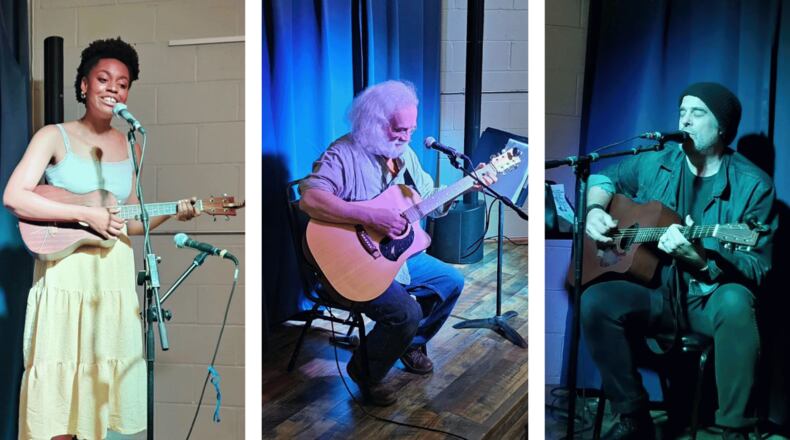In the gallery, the audience listens. It’s where performers work on their craft, and work on being paid attention to. Or at least that’s the intention of being autonomous from the main room, away from drink blenders and conversations (i.e. standard components of a working bar).
Though Showcase Thursday takes place at Yellow Cab Tavern, walking through the gallery door is sometimes like entering a portal into another realm: one where attendees agree to pipe down and respect whatever is happening on stage, whether transcendent or sub-par. It’s an equal-opportunity room; everyone gets applause and ears.
McKenzie is not shy about informing people of that fact.
He’s well-versed in giving dirty looks and shutting down the talkers — making him seem irritable and grumpy — but his frustrations are rooted in good intentions, for the performers’ benefit.
Showcase Thursday is the answer to what Mick Montgomery did with the Musician’s Co-Op at Canal Street, which McKenzie sporadically guest-hosted throughout its run. There’s far too much nuance between the venues for a one-to-one comparison, but the weekly Showcase may be the closest relative Musician’s Co-Op currently has in the Dayton music scene.
Every Thursday, about an hour before any fashionably late musician shows, McKenzie totes in his sound system into the brick-walled gallery. He grabs a couple of mic stands from the main stage, along with some XLR cables, DI boxes and SM58 microphones in preparation for the night ahead.
McKenzie often wears a solid-colored Carhart shirt, like a cartoon character with a closet of multiple of the same outfit. His plume of white hair protrudes like a mad scientist’s as he quickly plugs and patches everything in; it must be second nature at this point. Windsor — that is, McKenzie in show mode — can be calm, frazzled or a combination of the two.
In under an hour, the stage is set. The mics are hot and so are the spotlights.
The curious stagger in, as do some Showcase regulars. The rotating guest artists’ works displayed on the walls entertain while McKenzie sits behind the soundboard with a fresh beer, waiting for more to trickle in to occupy the mismatched chairs and futons.
And even if they’re not filled, which has been the case lately, the first act goes up when Windsor shuts the door and kills the house lights.
The room has a natural reverb; sounds bounce off the cement and are only slightly dampened by the absorption panels hung throughout the rafters. It’s not the ideal sonic scenario, but that’s part of the gallery’s charm.
The beauty of that room is that everyone in it is a de facto fan. Though, often, the performers — whom McKenzie curates via his budget scheduler — would make fans out of anybody.
During the pandemic, Showcase relocated to an outside stage in the warmer months, and the main stage when the weather started to turn. Maintaining the gallery’s quiet atmosphere was difficult since the bar still had to operate as a bar. The bigger crowds made McKenzie’s listening room feel more synonymous with an open mic: drinks first, music second.
It was eventually deemed safe to move Showcase back into the gallery and it returned to how it was. But, audience-wise, it never quite recovered.
“Don’t kid yourself... we had some dismally slow nights at the Co-Op,” Mckenzie said. “There was a slightly larger contingent who would come out frequently, but we’ve built a small, loyal audience here.”
The gallery has a maximum occupancy of 53 persons; the last few Showcases haven’t pulled anywhere near that. Though the room is objectively emptier, recurring faces do show.
“I think it’s just a sign of the times … people don’t think of live music as their first option,” McKenzie said.
But for some, the intimate listening room experience is unmatched.
Matt Baumann, a Cincinnati musician who used to play Canal Street, often makes the trek up I-75 to play Showcase. In his words: “Windsor keeps the spirit of the whole thing alive,” adding that Showcase is a comfortable and welcoming space for musicians.
Lately, to close out Thursday nights, McKenzie — a fine musician in his own right — has been doing what he refers to as “Windsor’s Corner”: a campfire-style, semi-sing-along unplugged performance from behind the soundboard. He’ll pull out Hank Williams’ or Louvin Brothers’ tunes like he’s a jukebox for songs that time forgot. He commands the room, acoustically, then thanks everyone for coming.
As he packed his equipment and wrapped up his cords one night, McKenzie said: “I feel sorry for the [ones] who weren’t here tonight.”
There’s a corkboard of upcoming performers’ names displayed outside the gallery door, but it’s never clear what’s going to happen at a Showcase Thursday — it could be an accomplished bluegrass band or a nervous first-timer — and that’s part of the magic: something people can only feel when they show up.
More details
Thursday Showcase happens every Thursday at Yellow Cab Tavern, 700 E. 4th St., Dayton. It takes place at 7:30 p.m., is hosted by Tim McKenzie and is always free.
About the Author
